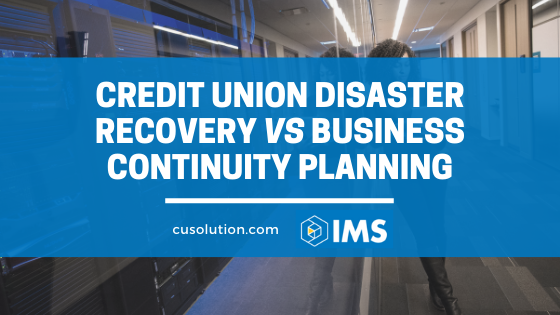 Most people use the terms “business continuity planning” and “disaster recovery” interchangeably, but they are two completely different strategies that organizations use to protect operations and bounce back from a disaster.
Most people use the terms “business continuity planning” and “disaster recovery” interchangeably, but they are two completely different strategies that organizations use to protect operations and bounce back from a disaster.
What are the main differences between business continuity plans and disaster recovery plans anyway? While the exact answer varies depending on who we ask, the general rule goes:
- A Business Continuity Plan (BCP) consists of a series of protocols made to make sure that an organization can continue operations during a disaster. It answers the question: “How can our credit union remain operational during a disruptive event?”
- A Disaster Recovery Plan (DRP) is often a subset of BCP and refers to the processes and tech needed for recovering from a disaster. It specifically pertains to recovering lost data and restoring failed infrastructure. This answers: “How does our credit union recover when a disaster strikes?”
Think of a BCP as a general strategy that businesses put in place to be able to continue operations with minimal disruption during a disaster. A DRP is much more specific. It’s a plan to recover the applications, data and other components that allow your organization to operate should your servers or data center get damaged or destroyed.
Why are both Business Continuity Plans and Disaster Recovery Plans important?
Now more than ever, credit unions have to guard against a number of threats that can hinder operations. Aside from natural calamities such as earthquakes, fires, hurricanes, or floods, you now have to protect yourself from man-made threats such as cybercrime and attacks from competitors or disgruntled employees. Without both of these plans in place, your credit union may face severe consequences.
According to a study by FEMA (Federal Emergency Management Agency), “following a disaster, 90% of smaller companies fail within a year unless they can resume operations within 5 days.” Without comprehensive plans for preparing for these events, financial institutions are wide open targets.
By focusing on creating and regularly updating both business continuity planning and disaster recovery planning, leadership can make sure that their credit unions can weather through these events.
How do BCPs and DRPs overlap?
In actual use, both plans are referred to when describing an organization’s disaster preparedness. However, it’s very important to remember that a comprehensive business continuity plan will always have a disaster recovery plan built right into it. Think of your BCP as a master document that covers all aspects of your credit union’s disaster prevention, management and response, including the necessary recovery protocols. You can’t have an effective business continuity plan without tackling how your credit union will recover from different kinds of disasters.
Are you ready to fully prepare your credit union for any potential disaster? IMS has your back. Learn more about our Business Continuity Planning and Disaster Recovery solutions!



